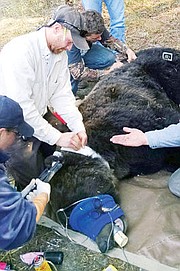Grizzly captured in residential area
Montana Fish, Wildlife & Parks captured a 500-pound male grizzly bear Monday near Snowshoe Road and relocated him to the head of Bear Creek in the Cabinet Mountains.
The bear, previously nicknamed Taz by wildlife officials, was initially captured and collared in 2011. He was born in the Yaak and collared at the age of two. The department lost contact with Taz when his collar dropped off in 2013. The collars attached to growing bears are programmed to release after set periods of time in order to prevent physical harm to the bears as they outgrow the collars.
Taz was trapped near the property of Libby-area residents Bill and Nancy Hogan, who had taken a number of steps to bear-proof their property. Taz wandered through an electric fence the Hogans were not aware was malfunctioning.
“They did everything that they needed to do in order to prevent a conflict between bears and humans,” Annis said. “The fence suffered mechanical failure through no fault of theirs, and they called for help and solved the problem without significant conflict or fatality.”
As a result of the incident, Taz has been given a surname. He is now affectionately known as Taz B. Hogan.
Sometime between 2013 and this year, Taz migrated from the Yaak to the Cabinets, making him the first documented case of a native grizzly migrating from one end of the Cabinet-Yaak ecosystem to the other.
Fish, Wildlife & Parks bear management specialist Kim Annis said the documentation of Taz moving is significant because it demonstrates the possibility of connectivity between the two ecosystems.
“One bear connectivity does not make,” Annis said. “But it is hopeful for what we want the future to look like for these bears.”
The long-term goal, Annis said, is for what are now two distinct populations to merge into one. She said between the two populations there are roughly 45 to 50 grizzly bears, according to data collected in 2012. The risk to those populations is much greater if they remain separate and distinct.
“Right now we have essentially two model populations,” she said. “Any significant mortality event can create great risk for extinction in one of them. If the populations have connectivity it diminishes the risk of a significant mortality event impacting the whole.”
Annis said beyond the connectivity of the Cabinet-Yaak ecosystem, bear management officials hope to eventually see connectivity between these bears and those of the Northern Continental Divide population, which includes bears in the Flathead, Glacier and other nearby areas. The department has seen a movement back and forth from bears which have been transplanted to the area, but not from native bears. Taz’s movement from the Yaak to the Cabinets has provided hope that such expanded connectivity can occur, but such movement has yet to be documented.
“There is no evidence of that connectivity yet from native bears,” she said. “Transplated bears don’t count.”



